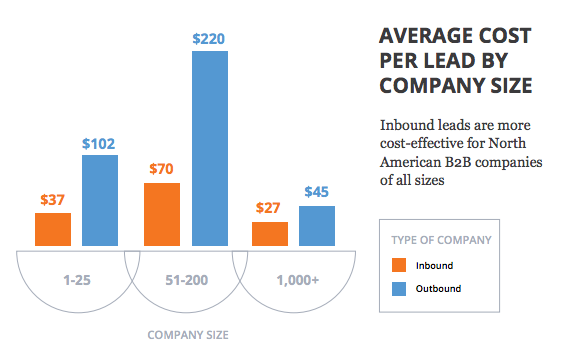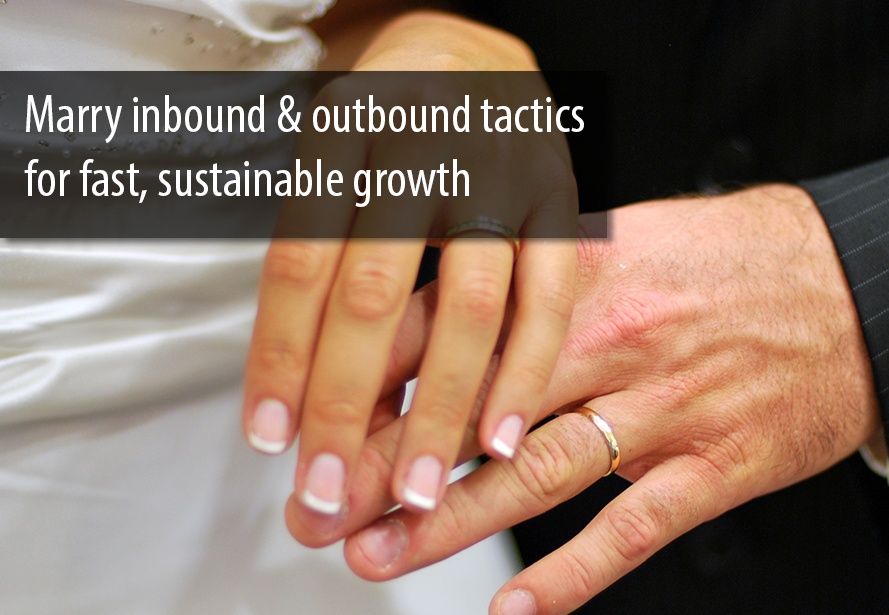Inbound vs Outbound Marketing: Get stronger results by knowing HOW and WHEN to use each.

There’s a huge difference between inbound and outbound marketing. In fact, the differences are so vast that inbound and outbound are often pitted against each other as diametrically opposed marketing methods. It’s not uncommon to hear the two positioned as “new vs old”, “pull vs push”, or “permission vs interruption”.
On the one hand, these simple inbound vs outbound descriptions are useful when it comes to explaining broad based differences between the two approaches. But if the conversation stops there, you’re only getting part of the story – the part that always positions inbound as the hero and outbound as the nemesis.
The full inbound and outbound story is about balance. It’s about using each approach at the optimal time to get the strongest results. And yes, it is possible for inbound and outbound marketing to work in harmony.
Here’s HOW and WHEN to use inbound and outbound marketing together for stronger results…
Inbound Marketing
Inbound relies on earning people’s trust and attracting qualified buyers to your business. It is customer centric and values delivering a strong customer experience (CX) throughout the buyer journey from discovery to satisfied customer.
Not only will inbound marketing help generate leads, convert customers, and deliver remarkable CX, but inbound marketing also results in a much stronger ROI than outbound. For instance, inbound delivers a significantly lower cost per lead than outbound.

source: HubSpot
With inbound marketing, the content you produce today – from blog posts and eBooks to videos and podcasts – will continue to work for you well into the future. For example, a blog post you write today can continue to drive organic traffic and convert visitors into leads years from now!
For these reasons, inbound and content marketing should be the cornerstones of your marketing activities.
But there are times when inbound marketing shouldn’t be your only focus.
Inbound marketing is a long game. It’s a marathon. And if you need fast results, inbound is not your answer. You start inbound marketing today, so you can realize the benefits months and years down the road. But for more immediate results, you need a fast-acting approach.
Outbound Marketing
Yes, outbound marketing is “interruption” marketing. Yes, it’s older. And yes, it is more expensive. But it’s also a lot faster than inbound.
Outbound marketing includes approaches like paid ads across radio, tv, and social media. It also includes direct mail, cold calling, and trade shows. These approaches don’t require months and years to produce results. Outbound marketing can produce immediate results...
...if you’re targeting and executing correctly.
To get stronger results from your outbound marketing, be sure to leverage the target audience and persona research you’ve completed as part of your inbound strategy. The more detailed information you have about your buyer personas, the better you can target your ads. And the more effective they’ll be!
Also, before jumping straight into your ad spend, leverage inbound to test your key messages and creative assets. You can pre-test imagery and calls to action across social media, your blog, and your existing email file. Keep an eye on which messages and assets resonate most strongly with your ideal buyers. Then, use those findings as a starting point for your paid outbound ads.
Fast-acting outbound tactics are great to use when you have a new business, product or niche market that you want to tap into. In these cases, outbound gives your marketing the “boost” it needs in the immediate term while you’re ramping up inbound efforts.
Conclusion
It costs more per lead to use outbound marketing, and it delivers a lower overall ROI compared to inbound marketing, but that doesn’t mean outbound should be ignored altogether. Think of outbound as your marketing nitro – it’s the extra boost your marketing may need to generate leads and bring in new customers now while you’re working hard to jump-start your inbound.
Inbound vs. outbound marketing is not an either-or discussion. It’s about having a complete marketing toolbox at your fingertips and using the right tool at the right time.
What are your approaches for balancing inbound and outbound marketing?
Image by Broadway Tour via Flickr, licensed under CC BY-SA
Share this
You May Also Like
These Related Stories

Marrying Inbound Marketing with Traditional Tactics for Startup Success

What's the Most Cost-Effective Way to Generate Leads?


/Accreditations/CRM-Implementation-Accredited-Badges.png?width=170&height=138&name=CRM-Implementation-Accredited-Badges.png)
/Accreditations/Onboarding-Accredited-Badges.png?width=170&height=137&name=Onboarding-Accredited-Badges.png)
/Accreditations/Custom-Integration-Accredited-Badges.png?width=170&height=137&name=Custom-Integration-Accredited-Badges.png)

